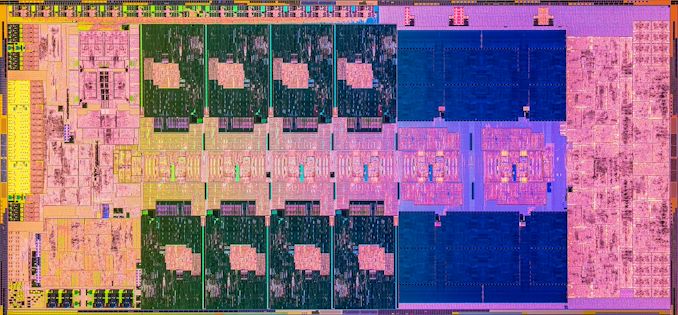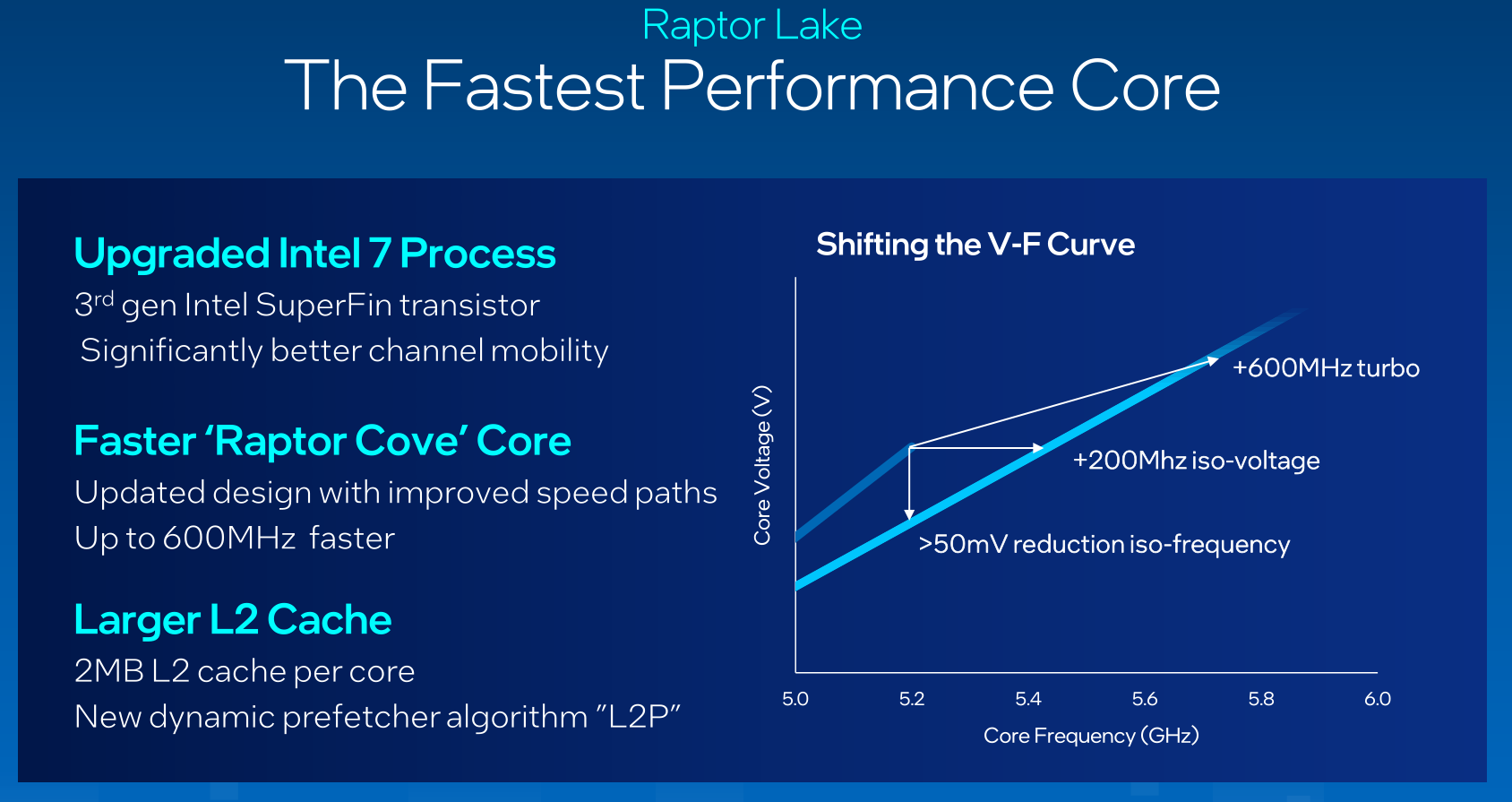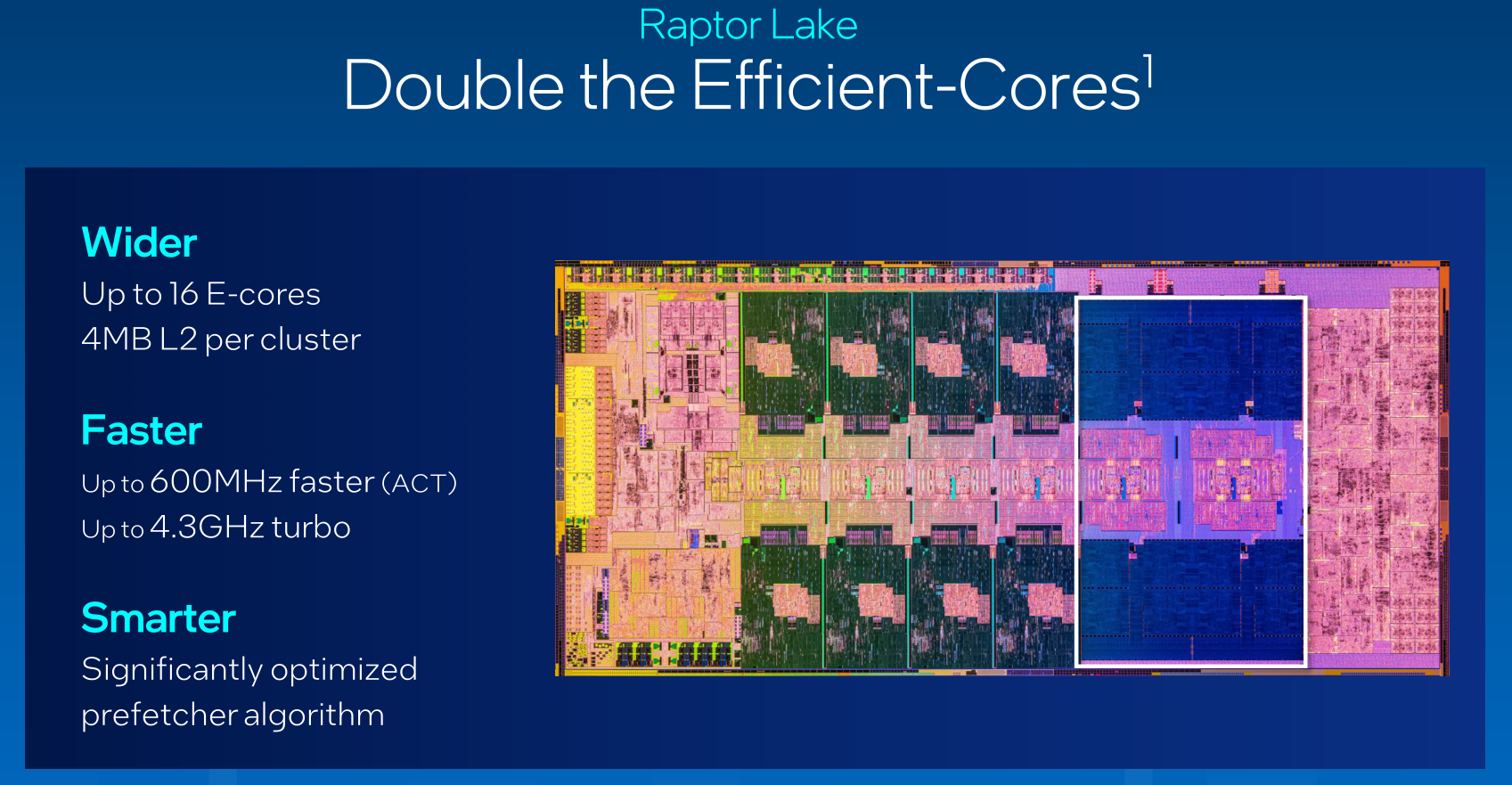Intel Core i9-13900K and i5-13600K Review: Raptor Lake Brings More Bite
by Gavin Bonshor on October 20, 2022 9:00 AM ESTRaptor Lake In Detail: Raptor Cove P-Cores, More Efficiency Cores
When it comes to architecturally dissecting the differences between Intel’s Alder Lake and Raptor Lake processors, both are based on a similar process. Intel’s 12th Gen Core (Alder Lake) series and the latest 13th Gen Core (Raptor Lake) are based on its Intel 7 manufacturing processor, although this isn’t to be confused with 7 nm, as Intel 7 is a 10 nm process node. This means that Raptor Lake isn't a new core so to speak, especially not a redesign of its existing 10ESF core, but more augmentation. Intel has opted for improvements to its underlying memory and cache structures.

Intel Raptor Lake Core die image (Core i9-13900K)
The new Raptor Cove performance (P) cores replace the previous Golden Cove variants, with Intel specifying that Raptor Cove is based on an ‘enhanced’ version of its Intel 7 process using its 3rd generation of SuperFin transistor. With this newly optimized process combined with a better overall VF curve over the last age, Intel hopes to leverage the benefit from a higher frequency without increasing power levels too much.
Focusing on changes to the cache, the 13th Gen Core series has more L2 cache. For the new Raptor Cove core, Intel has added more L2 cache when compared to Alder Lake, with 1.6x more with 2 Mb per P-core. The levels of L2 cache assigned to each array of E-cores now equates to 4 Mb; up from 2 Mb. This means Intel has improved the L2 cache on both core types. For the L3 cache, Intel hasn't made any strides and has left things unchanged.
Adjusting to the Voltage Frequency (VF) cure has allowed Intel to squeeze out even more gains about frequency versus voltage. In the case of Raptor Lake, Intel has managed to increase the peak P-Core frequency by a significant amount, up to 1 GHz in some cases. An example is the Core i9-13900K which has a maximum turbo frequency of up to 5.8 GHz; this equates to just over 11.5% over the Core i9-12900K. As per the released V/F curve optimizations, Intel has managed to eke out 200 MHz at ISO-Voltage, with a reduction of 50 mV at ISO frequency.
One thing to highlight about Intel’s 13th Gen Core series processors is the discrepancy between the base TDP, which for its entire launched stack (as of 10/20) is 125 W. The turbo or PL2 values are the same for the Core i9 and Core i7 models which are set at 253 W. This is an increase of 12 W from the corresponding 12th Gen Core i9 chips (241 W), and up by 63 W on the Core i5 series like for like. With the element of adding double the amount of E-cores, even with a more efficient V/F curve, there had to be tradeoffs when it came to power.
Raptor Lake and E-Cores: Same Gracemont Cores, Just More of Them
As we reviewed the previous generations of Intel Core i9-12900K processors, Intel has kept the same Gracemont-based Efficiency (E) core for Raptor Lake. The key difference when comparing the flagships of both generations, the Core i9-13900K has double the amount of E-cores compared to the previous generation. The doubling of E-cores in combination with the refined Raptor Cove core design for the P-cores means that the Core i9-13900K now has a total of 24-cores, with other SKUs benefitting from an increase in E-cores too.
Still, even with double the E-cores, the power penalty for doing this shouldn’t be an issue, at least not from a cooling perspective. As is with a high-performance processor and the high PL1/PL2 power it needs to stretch its legs, premium cooling would never go a miss. Intel isn’t officially recommending a minimum limit to cooling, but a low-performance cooler will almost guarantee thermal throttling as the Thermal Velocity Boost (TVB) for 13th Gen is set to 70°C.
In addition to the changes above, Intel’s 13th Gen Core series (unlike AMD’s Zen 4) offers support for both DDR5 and DDR4 memory. Further to the previous 12th Gen, the 13th Gen now supports faster DDR5 memory (DDR5-5600 versus DDR5-4800), an increase of 16.6%. Bandwidth and speeds for DDR4 memory remain at 3200 MT/s. Still, it allows users to match a lower-value processor without paying over the odds for DDR5 memory, which should decrease in price over time (hopefully).
Intel Thread Director: Windows 11 22H2 (or Newer) is Recommended
Since Intel’s 12th Gen Core series launch late last year, there was much furor around task scheduling in combination with Intel’s (new at the time) Thread Director built into the cores. While there were clear issues with Thread Director in combination with Windows 10, the Windows 11 operating system alleviated the issue of parking high single-threaded workloads on cores that otherwise wouldn’t be the best option (E-Cores). Although Windows 10 did in essence work with Intel Thread Director, it wasn’t really good at highlighting efficiency, and this is where Windows 11 came into play for optimal performance with Alder Lake.
Fast forward to now, and with all the additional E-cores in play with Raptor Lake, the latest update at the time of writing, Windows 11 22H2, offers the latest enhancements in the partnership between Intel, Microsoft, and the inner workings of Intel’s Thread Director. With a hybrid architecture and non-optimized software, it makes things a bit of a mess, but as per Intel’s guidance, they do recommend users use Windows 11 with 22H2 (or newer) for optimum performance when using 13th Gen Core series processors.
Over the next page is more information about the latest Z790 chipset which accompanies the Raptor Lake processors with this launch. From then on in, we'll detail our new CPU suite for 2023 and beyond, as well as see if Intel's 13th Gen Core Raptor Lake series can take a bite out of the competition. The associated pages and their contents are highlighted below:












169 Comments
View All Comments
WannaBeOCer - Friday, October 21, 2022 - link
Did you even read the article? Intel advertises the 13900k as a 253w chip. It drew 32% more than it advertised while AMD advertises its 7950x as a 170w and it drew 30% more than they advertised.“Processor Base Power
125 W
Maximum Turbo Power
253 W” Reply
Wrs - Friday, October 21, 2022 - link
You're comparing the PL2 of one chip with the TDP of the other. Also, the article mentioned the motherboard may have something to do with ignoring the PL2 on the 13900k.If the chip can't dissipate PL2, it'll incrementally step down to TDP gracefully. It's like you're complaining your 130mph sedan went 165mph on the race track... Reply
Gastec - Sunday, October 23, 2022 - link
Oh, so the motherboards are the culprits for overclocking the CPU's to new height of financial success, not Intel? ReplyWhatYaWant - Thursday, October 20, 2022 - link
7600x seems a bit overpriced, doesn’t it? Replyingwe - Thursday, October 20, 2022 - link
Yeah it does. $250 seems like a better price--maybe even a bit lower. It will probably come down. I just picked up a 5600 for $125 though so I am set. I suspect that the price will only come down on the 7600x once the stock of 5 series is cleared out. Replymeacupla - Thursday, October 20, 2022 - link
I am happy that Raptor Lake offers stiff competition to Zen 4. Hopefully AMD brings down the price of 7600X, and hurry up and launch their B650 boards Replycaqde - Thursday, October 20, 2022 - link
?? B650 is released? At least on Newegg and amazon you can purchase a selection of B650 motherboards today. Out of the 23 boards listed, 1 is out of stock and 5 are preoders for the 21st or 27th. So that leaves 17 boards that you can purchase today that are in stock, the in stock boards go from 170-350 (Asrock 650M PG Riptide and Gigabyte B650E Aorus Master respectively). But yeah AMD should and from what I have heard can lower Zen 4 prices to compete with Intel's prices. Replyhaukionkannel - Thursday, October 20, 2022 - link
When AMD release 3d cache versions, it will reduce the prices of normal versions.How much, is interesting question. I expect that AMD also will release 7600 to compete with intel in price, so 7600x may not come down a lot. Reply
meacupla - Thursday, October 20, 2022 - link
Oh, B650 is out already? I saw no news coverage of them, so I thought they were still waiting to be released. Replytechguymaxc - Thursday, October 20, 2022 - link
You list Handbrake under legacy tests however, either the graphs or mislabeled or the tests are not included. Did you test these CPUs with Handbrake? If so, please post the results. If not, please consider testing and updating the article. This is the only workload that matters to me, and the number one reason I come to Anandtech for CPU reviews/benchmarks. Reply